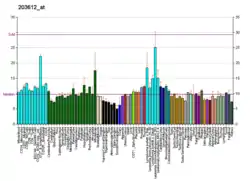BYSL
Bystin is a protein that in humans is encoded by the BYSL gene.[5][6][7]
Function
Bystin is expressed as a 2-kb major transcript and a 3.6-kb minor transcript in SNG-M cells and in human trophoblastic teratocarcinoma HT-H cells. Protein binding assays determined that bystin binds directly to trophinin and tastin, and that binding is enhanced when cytokeratins 8 and 18 are present. Immunocytochemistry of HT-H cells showed that bystin colocalizes with trophinin, tastin, and the cytokeratins, suggesting that these molecules form a complex in trophectoderm cells at the time of implantation. Using immunohistochemistry it was determined that trophinin and bystin are found in the placenta from the sixth week of pregnancy. Both proteins were localized in the cytoplasm of the syncytiotrophoblast in the chorionic villi and in endometrial decidual cells at the uteroplacental interface. After week 10, the levels of trophinin, tastin, and bystin decreased and then disappeared from placental villi.[7]
References
- GRCh38: Ensembl release 89: ENSG00000112578 - Ensembl, May 2017
- GRCm38: Ensembl release 89: ENSMUSG00000023988 - Ensembl, May 2017
- "Human PubMed Reference:". National Center for Biotechnology Information, U.S. National Library of Medicine.
- "Mouse PubMed Reference:". National Center for Biotechnology Information, U.S. National Library of Medicine.
- Pack SD, Pak E, Tanigami A, Ledbetter DH, Fukuda MN (Mar 1999). "Assignment1 of the bystin gene BYSL to human chromosome band 6p21.1 by in situ hybridization". Cytogenet Cell Genet. 83 (1–2): 76–7. doi:10.1159/000015131. PMID 9925933. S2CID 33756326.
- Miyoshi M, Okajima T, Matsuda T, Fukuda MN, Nadano D (May 2007). "Bystin in human cancer cells: intracellular localization and function in ribosome biogenesis". Biochem J. 404 (3): 373–81. doi:10.1042/BJ20061597. PMC 1896285. PMID 17381424.
- "Entrez Gene: BYSL bystin-like".
- Suzuki N, Zara J, Sato T, Ong E, Bakhiet N, Oshima RG, Watson KL, Fukuda MN (Apr 1998). "A cytoplasmic protein, bystin, interacts with trophinin, tastin, and cytokeratin and may be involved in trophinin-mediated cell adhesion between trophoblast and endometrial epithelial cells". Proc. Natl. Acad. Sci. U.S.A. 95 (9): 5027–32. Bibcode:1998PNAS...95.5027S. doi:10.1073/pnas.95.9.5027. PMC 20207. PMID 9560222.
External links
- Human BYSL genome location and BYSL gene details page in the UCSC Genome Browser.
Further reading
- Suzuki N, Zara J, Sato T, Ong E, Bakhiet N, Oshima RG, Watson KL, Fukuda MN (1998). "A cytoplasmic protein, bystin, interacts with trophinin, tastin, and cytokeratin and may be involved in trophinin-mediated cell adhesion between trophoblast and endometrial epithelial cells". Proc. Natl. Acad. Sci. U.S.A. 95 (9): 5027–32. Bibcode:1998PNAS...95.5027S. doi:10.1073/pnas.95.9.5027. PMC 20207. PMID 9560222.
- Suzuki N, Nakayama J, Shih IM, Aoki D, Nozawa S, Fukuda MN (1999). "Expression of trophinin, tastin, and bystin by trophoblast and endometrial cells in human placenta". Biol. Reprod. 60 (3): 621–7. doi:10.1095/biolreprod60.3.621. PMID 10026108.
- Nakayama J, Aoki D, Suga T, Akama TO, Ishizone S, Yamaguchi H, Imakawa K, Nadano D, Fazleabas AT, Katsuyama T, Nozawa S, Fukuda MN (2004). "Implantation-dependent expression of trophinin by maternal fallopian tube epithelia during tubal pregnancies: possible role of human chorionic gonadotrophin on ectopic pregnancy". Am. J. Pathol. 163 (6): 2211–9. doi:10.1016/S0002-9440(10)63579-1. PMC 1892375. PMID 14633596.
- Rual JF, Venkatesan K, Hao T, Hirozane-Kishikawa T, Dricot A, Li N, Berriz GF, Gibbons FD, Dreze M, Ayivi-Guedehoussou N, Klitgord N, Simon C, Boxem M, Milstein S, Rosenberg J, Goldberg DS, Zhang LV, Wong SL, Franklin G, Li S, Albala JS, Lim J, Fraughton C, Llamosas E, Cevik S, Bex C, Lamesch P, Sikorski RS, Vandenhaute J, Zoghbi HY, Smolyar A, Bosak S, Sequerra R, Doucette-Stamm L, Cusick ME, Hill DE, Roth FP, Vidal M (2005). "Towards a proteome-scale map of the human protein-protein interaction network". Nature. 437 (7062): 1173–8. Bibcode:2005Natur.437.1173R. doi:10.1038/nature04209. PMID 16189514. S2CID 4427026.
- Olsen JV, Blagoev B, Gnad F, Macek B, Kumar C, Mortensen P, Mann M (2006). "Global, in vivo, and site-specific phosphorylation dynamics in signaling networks". Cell. 127 (3): 635–48. doi:10.1016/j.cell.2006.09.026. PMID 17081983. S2CID 7827573.




